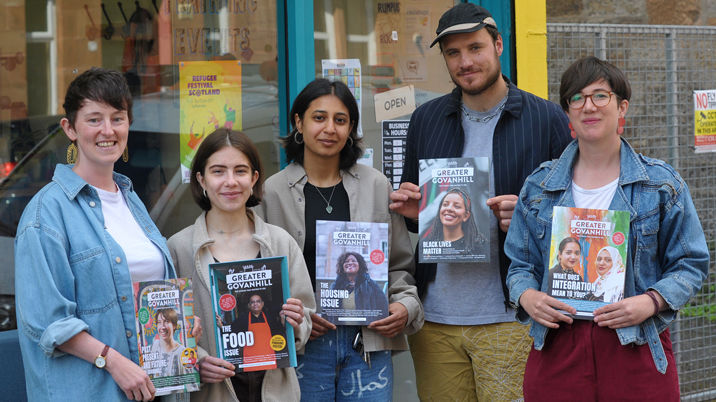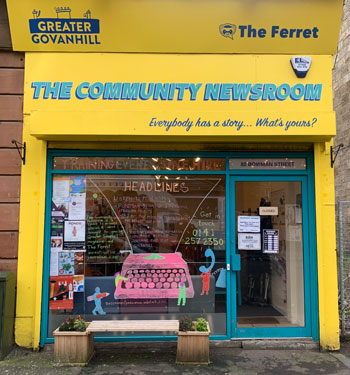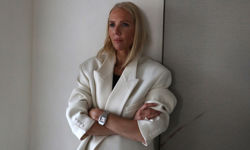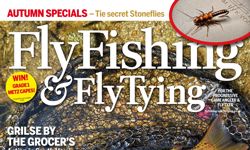
Thanks to its reputation as a rich cultural melting pot, Govanhill has been described as Glasgow’s Ellis Island in reference to the New York island where millions of immigrants to the United States were once processed. The first immigrants to this area south of the River Clyde close to the city centre came from the Highlands and Ireland, later from Pakistan and Bangladesh, and more recently from eastern Europe including a significant population of Roma people.
Part of Nicola Sturgeon MSP’s Glasgow Southside constituency, Govanhill sometimes gets a bad rap. But it is an incredibly vibrant area popular with artists as many of the sandstone tenements are owned by housing associations, keeping rents low and resisting gentrification.
Such a diverse and interesting community deserves a local media that reflects its character, and it now has this in Greater Govanhill, a bi-monthly magazine and website set up in 2020 by Rhiannon Davies. It is part of a new movement rethinking local journalism, alongside the Manchester Mill, the Birmingham Dispatch and the Bristol Cable.
A real buzz
Davies, who moved to Govanhill in 2018, explains: “I was immediately struck by how people spoke about Govanhill, how it’s often portrayed in the majority of the mainstream media versus the reality of actually living here and finding this vibrant community with lots of stuff going on. What it is, is this warm, energetic melting pot of different cultures with loads of people and projects and social enterprises and activism and all this great stuff happening and what I found was people weren’t speaking about that, they were only speaking about the bad stuff.”
She had the idea of setting up a magazine that would allow people to tell their own stories, and spent a year talking to local people, businesses, and community groups finding out what they would like to see from such a publication. Her next step was to go through a social enterprise incubator process as she wanted to set up a community interest company that was going to be long-lasting, not just a one-off.
The magazine and website were about to launch when Covid struck. Rather than be deterred, Davies decided to treat it as an opportunity to share local information online about services, where you could buy food and facemasks and get vaccinated. In November 2020, the first physical edition of the magazine was published with 5,000 printed copies, to which 50 people had contributed in some way. “50 people from 13 different countries aged between 12 and 89 — so it was a real community,” Davies recalls.
Less than one year after launching, Greater Govanhill was named Regional Magazine of the Year at the News Awards, beating much bigger and more established titles. This year, it won the Reporting Communities Award at the Regional Press Awards, where the judges said Govanhill was well served by the publication: “It had a mission and spoke for the community it served, was vibrant and produced great stories.”
Breaking down barriers
In launching the magazine, Davies aimed to provide a platform for local voices that would bring the community together and break down barriers. The printed format is well-placed to do that, she believes: “You might not think you care about the history of the Roma people, but you might care about what’s happening with our bins and in a printed magazine, you put those things together and more people are likely to read the different stories that exist within it.”
Volunteers deliver the magazine — which is now bimonthly, with 4,000 copies printed per issue — door to door, as well as putting it into local shops, hairdressers, cafés, restaurants, doctors’ surgeries, and community spaces. They also work with local foodbanks to put it into support packs so it can reach those people who are most isolated. In addition, there is a membership model, with members invited along to editorial meetings where they can help to set themes for subsequent issues.

In December 2022, they opened a community newsroom on the high street in Govanhill, shared with journalism cooperative The Ferret. This is also operated as a co-working space, renting out desks, to make it sustainable. There are now five team members and one of them will usually be in the newsroom, or if not, someone else will take a message.
“The idea is that people can walk in off the street and talk to us. It’s probably one of my favourite things about working for Greater Govanhill, the chats that you have. Having that direct link with your community means you’re kept connected, but it also means you’re accountable and accessible,” explains Davies.
She adds: “That’s often what has become missing from local journalism. Most corporately owned publications are either operated remotely, they don’t have journalists in the local area, or if they do, they’re based out of town and they’re not any longer accessible in the way newsrooms used to be. I think people really like that and value it as well.”
The magazine’s creative director is Laura Hurst, a print-based graphic designer who got in touch with Davies when she heard about the plans for the publication. The idea is that it is bright and colourful without being “so modern and hipster that it’s exclusive”, as well as being accessible to people who don’t have English as a first language.
Value-driven journalism
They hire people not just based on their experience and qualifications, but on the different perspectives they bring and their connection to the local area. Members of the team who had no previous journalism experience have been highly commended at the Scottish Press Awards. They also do a lot of journalism skills training with people from under-represented backgrounds such as Roma youths and those who have experienced health inequalities to give them the skills to write and produce stories they care about. “We’ve seen from that people have gone on to journalism school, or to get a BBC apprenticeship or to have opportunities they wouldn’t previously have,” says Davies.
Although they do get some income from ad sales both in the print magazine and online, their biggest source of income is currently grant funding. This tends to be for project specific grants for work that is community led, reducing stigma, and connecting people.
“Because the way that we see our journalism is value driven as opposed to being profit driven, we’re making enough money to pay ourselves, and produce the magazine, but we’re focused on the impact we want to make,” Davies explains.
One such project is FONDS, a podcast which won Best Limited Series at the 2024 Publisher Podcast Awards. This stemmed from a mural showing the letters of ‘Govanhill’ each painted with a different pattern representing a community conversation where people showed something from their own heritage that was important to them.
Davies recalls, “I really wanted to know about the objects, so I got this idea about doing this project focused on what is it that people bring with them from their home country which means something special to them?”
Photographer Morwenna Kearsley used a technique where she shot the objects — including a homemade box of spells, a silver bottle with a moon and star-shaped lid from Pakistan, and a Nicaraguan horse-head mask — in a darkened room with a moving torch using an 8-minute exposure. This short time and intimate setting provided the perfect opportunity for an interview with the person about the item they held dear.
After going to university in Brighton and working in political communications in Bristol, Davies got itchy feet and ended up living in Turkey where she wrote a column for an English-language national newspaper and later became arts and culture editor for a glossy lifestyle listings magazine in Istanbul. But around that time, there were anti-government protests in Turkey leading to a crackdown on the media, making her realise she wanted to do something more. She returned to the UK and came to Glasgow to do an MA in media communications and international journalism. Following a six month journalism traineeship in Brussels, she started working for a news start up in Glasgow and teaching journalism at Strathclyde University.
Accentuating the positive
She is a passionate advocate of constructive journalism, using the power of media to highlight the good stuff in society rather than simply focusing on injustice.
“People really like reading about the good stuff that’s happening. Sometimes we look at what’s worked elsewhere, if we’ve got an issue on rubbish for example, how they tackle it in Edinburgh or in Vienna or in Delhi and try and share those ideas and learn,” she explains.
They are now looking at how they could create a similar concept in different areas, as well as expanding the consultancy arm of Greater Govanhill with a new organisation called Greater Community Media. Last year, they helped to launch the Scottish Beacon, a collaborative of 24 independent news publications based around Scotland. Last year, she spent six months in the US where they have more philanthropic funding, visiting innovative local news organisations that are providing an antidote to the polarisation happening in the national media. Here in the UK, she believes we need more funders to recognise the value of good local journalism, as well as to consider state funding.
“If we don’t do something now to bring more money into the industry, to bring more innovation into the industry, then we end up risking losing this really valuable part of local democracy,” she says.
But there is plenty of room for optimism. “What’s happening in all these places up and down the country where independent media is growing and flourishing, is that people are doing it in a way that is on based on listening to a community as opposed to extracting from a community. Journalism should be a service and should be rooted in care and in love for a place.”
This article was first published in InPublishing magazine. If you would like to be added to the free mailing list to receive the magazine, please register here.












